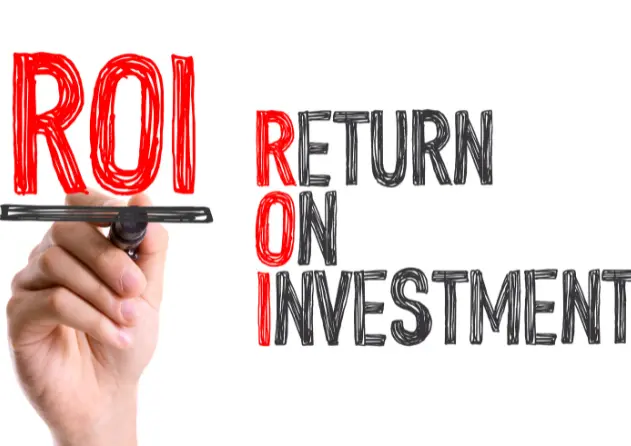Investing in property is a proven way to build wealth over time through capital growth and rental income. According to our research at API Global, the average property price in the UK has increased by over 70% in the last decade, representing an annual return of nearly 7% per year. For savvy investors focused on up-and-coming UK property areas, the returns can be even higher.
Knowing how to calculate investment property return is one of the primary steps towards making informed investment decisions. We understand this at API Global and have taken the time to put together this detailed guide, exploring ROI calculation examples, factors impacting this metric, tips for maximising rental returns, and more.
How to Calculate Return on Investment for Rental Property
The formula for ROI calculation in real estate is a ratio of the net profit made from the property to the cost of the property.
For example, if an investor paid £100,000 in cash for a rental property, incurred a yearly expense of £3,600, and earned a rental income of £12,000 (with a £1,000 monthly rent), the ROI is calculated as follows:
ROI = (Net Profit / Cost of Property) x 100%
Here are the key elements of the formula:
- Cost of the Property: This is the property purchase price. In this case, the investor paid £100,000 for the rental property.
- Annual Rental Income: This is the money earned from renting out the property annually. According to our example, the investor earned £12,000 in rental income over 12 months.
- Net Profit: This is the net operating income, and the formula is annual rental income minus any expenses associated with the property (like maintenance costs, taxes, insurance, etc.).
Net Profit = Annual Rental Income – Expenses
According to our scenario, the investor incurs £3,600 in expenses, hence making a Net profit of £8,400 (i.e., £12,000 – £3,600).
So, in the scenario cited above, the ROI would be (£8,400 / £100,000) x 100 = 8.4%

This means for every pound invested in the purchase price of the property, the investor earns 8.4 pence as a return yearly. Investors can also use a property ROI calculator if they’re not confident working with numbers.
How to Calculate ROI on Rental Property With a Mortgage
Properties are often bought with a mortgage, which can add some complexity when calculating ROI. The first step in computing investment property calculations for assets bought with a mortgage is to calculate the property’s cash flow and the cash-on-cash return.
The cash flow is the annual rental income minus expenses (like taxes, insurance, and maintenance) minus mortgage payments.
Cash Flow = Annual Rental Income – Expenses – Mortgage Payment
The cash-on-cash return is the cash flow divided by the total cash invested, which is the down payment plus any capital expenses.
Cash-on-Cash Return = Cash Flow / Total Cash Invested
Where:
Total Cash Invested = Down Payment + Capital Expenses
For example, if an investor purchases a £250,000 rental property with a 20% down payment of £50,000 and takes out a £200,000 mortgage, the numbers may look like this:
- Annual Rental Income: £15,000
- Expenses (Taxes, Insurance, Maintenance): £5,000
- Monthly Mortgage Payment of £750: £9,000 annually
- Cash Flow (Annual Rent – Expenses – Mortgage Payment): £1,000
- Down Payment: £50,000
- Cash-on-Cash Return [(Cash Flow / Total Cash Invested) x 100%]: 2%
Entering the above figures into an ROI for rental property calculator will generate a 2% return. While 2% may seem low, the investor is also benefiting from capital appreciation when selling real estate. After several years, the increased equity and rental increases can significantly boost the cash flow and overall ROI.
The key to maximising ROI is finding property developments in up-and-coming areas with the potential for strong capital growth and rental demand. Conducting thorough due diligence on the neighbourhood and comparing the projected returns to other investment options can help determine if the risks outweigh the rewards. For international investors unfamiliar with the UK market, consulting expert advisors is highly advisable.
That said, investment property returns can vary for several reasons, and investors should look into these factors before making an investment decision. The following section explores these factors.
3 Factors That Impact Investment Property Returns
Having known how to calculate ROI on rental property, it’s crucial to understand what might impact the value, including:
- Capital growth
- Expenses
- Vacancy Rates
1. Capital Growth
Capital growth refers to the increase in a property’s value over time. Historically, property values in the UK have risen steadily at around 7% per annum. However, some areas, especially up-and-coming cities and towns, have experienced higher growth and are the best places to invest in property. Choosing an area with a strong potential for price appreciation can significantly boost returns.
2. Expenses
Expenses, such as management fees, maintenance costs, insurance, and tax, reduce net returns. Carefully evaluating all expenses and fees before purchasing a property is critical. On average, expenses claim around 1% of the property value per year.
3. Vacancy Rates
Vacancy rates also impact returns. Even in a healthy rental market, some vacancy is inevitable. Investors should always calculate rental yield and potential returns, assuming a 5–10% vacancy rate as a precaution. Areas with stable, diversified economies and workforces tend to have lower vacancy rates.
With thorough research and prudent decision-making, property investors in the UK can achieve healthy, long-term returns on their investments. Carefully crunching the numbers and determining returns using reliable data and reasonable assumptions is key to investment success. Let’s go through how you can select the right locations to maintain low vacancy rates and boost returns on property below.
How to Choose the Right UK Locations for Optimal Returns
It’s not enough to know how to calculate the return on property investment; there are other factors to consider, as listed above. More importantly, investors seeking the best returns must prioritise location, particularly those in up-and-coming areas poised for strong capital growth.
Here are 2 pro tips when it comes to selecting a property investment location:
- Choose areas with improved infrastructure.
- Choose areas offering easy commute and leisure activities.
1. Choose areas with improved infrastructure.
The location of an investment property plays a crucial role in its success. Areas experiencing infrastructure improvements, economic growth, and gentrification often see property values rise over time. For investors seeking capital appreciation in addition to rental income, identifying these emerging locations is key.

The Midlands and North of England have become attractive targets for investors. Due to lower property costs and major regeneration projects, the best places to buy outside London include Birmingham, Kent (in Ashford), Manchester, and Liverpool. For example, Birmingham’s Big City Plan aims to build over 5,000 new homes and create 50,000 new jobs. Areas surrounding these cities also offer appealing opportunities.
2. Choose areas offering easy commute and leisure activities.
Transport links boost an area’s desirability and property values. The arrival of HS2, the high-speed rail line connecting London and Birmingham, makes cities along its route worthwhile considerations. Stations within a 30-minute commute of city centres, in particular, may see substantial increases in demand.
Coastal cities in the South West and Wales provide scenic surroundings that appeal to both residents and holidaymakers. As more people seek a better work-life balance, especially following the COVID-19 pandemic, seaside towns stand to gain popularity. Property by the sea, especially in picturesque, historic locations, tends to hold value well over time.
By identifying areas with indicators of strong economic and infrastructure growth, as well as long-term desirability, investors can target locations poised to outperform the wider market. Choosing the optimal location is the first step to building a property portfolio for maximum returns. To make an informed location decision, we recommend investors contact their wealth advisor.
4 Tips for Maximising Investment Property Profits
To boost return on investment property, investors should employ strategies aimed at increasing rental income and capital gains.
Here are 4 expert tips:
- Increase rents.
- Reduce vacancy periods.
- Add value.
- Sell at the optimal time.

1. Increase rents.
Property owners can raise rents to match current market rates, especially if rental demand is high in the area. Rent increases should be reasonable, around 5–10% per year, to avoid losing long-term tenants. Reviewing rents also helps combat inflation.
2. Reduce vacancy periods.
Keeping units occupied is key to optimising rental income. Owners should price units competitively, advertise widely on listing sites, and offer move-in incentives when possible to attract tenants quickly. Preparing units with desirable features and furnishings also helps make properties more rentable.
3. Add value.
Renovating and improving properties enhances their capital value over time. Upgrades like new kitchens and bathrooms, energy-efficient windows, and landscaping have high returns on investment.
Owners can also extend or convert properties to add space. Value can likewise be added by obtaining planning permission for more profitable uses, like Airbnb. These improvements allow owners to charge higher rents and sell at a premium.
4. Sell at the optimal time.
Investors should monitor the property market and economy to determine the best time to sell for maximum gain. Typically, selling when demand is high, property availability is low, and price growth is rapid will result in the largest capital returns. Owners can potentially generate profits of 10% per year or more over the holding period, especially if they invested in an up-and-coming area set to experience strong future growth due to factors like new infrastructure development or gentrification.
With intelligent management and strategic improvements, investment property owners can boost both rental income and capital profits well above average market returns. Paying close attention to operating costs also contributes to the bottom line. Over time, these combined efforts can result in an extremely profitable investment with a high rental yield.
Frequently Asked Questions
How do you calculate the total return on an investment property?
To calculate the total return on an investment property, use the following formula:
ROI = (Investment Gain / Investment Cost) x 100%
For example, for a property purchased for £150,000 and sold for £200,000, the investment gain is £200,000 – £150,000 = £50,000.
Then the ROI is (£50,000 / £150,000) x 100% = 33%
That’s how to work out ROI for a property that generated no rental income (assuming there are no maintenance expenses).
For a buy-to-let property bought for £150,000 in cash, incurred an expense of £3,600, and generated an annual profit of £12,000 (with a £1,000 monthly rent), the ROI for a year is calculated as follows:
[(£12,000 – £3,600) / £150,000] x 100% = 5.6%
And if the property is sold for £200,000 after this one year, the ROI is computed as follows:
[(£200,000 – £150,000 + £12,000 – £3,600) / £150,000] x 100% = 38.9%
For rental properties purchased with a mortgage, the ROI is calculated by subtracting the annual costs of operation from the annual rental income and dividing it by the mortgage value (go to the first section of this guide to learn more).
In a nutshell, understanding these property calculations is crucial to assessing the profitability of a real estate investment.
What is a good ROI for rental property?
A good ROI on an investment property typically falls into the 8% to 12% range, though many investors might aim for higher returns. However, it’s crucial to note that ROI isn’t the sole measure of a property’s profitability; other factors, such as property location, market trends, and long-term growth potential, also play a significant role. While a high ROI can indicate immediate profitability, a comprehensive evaluation of all aspects is essential for successful long-term real estate investments.
How do I calculate ROI on rental property in Excel?
Calculating ROI on rental property in Excel is straightforward.
- Begin by inputting the investment’s profit or loss and its initial cost in separate cells. For example, enter the investment gain in cell A2 and the investment cost in cell B2.
- The ROI is computed in another cell by dividing the gain by the cost. This can be done by pasting this expression in the cell: =A2/B2.
- The result can then be formatted as a percentage, yielding the ROI on the rental property.
Remember, this formula assumes all profits and losses are accounted for in the gain, including annual rental income and operating costs.
Is total return the same as IRR?
Total return and IRR (Internal Rate of Return) are both valuable measures in investment analysis, but they are not the same.
Total return represents the overall growth of an investment from start to finish, expressed as a percentage of the initial investment. On the other hand, IRR is the annual growth rate that makes the net present value of all cash flows (both positive and negative) from an initial investment value.
While these metrics may coincide over one year, they will differ for longer durations due to the time value of money.
Conclusion
Investors should calculate investment property return to determine if an opportunity is viable and fits within their financial goals. By following the methods and formulas outlined in this guide, investors can gain a data-driven understanding of the projected rental income, appreciation, cash flow, and overall return on investment for a specific property.
For investors seeking strong cash flow and long-term capital growth, up-and-coming areas of major UK cities that are poised for future development and infrastructure improvements may offer the highest potential returns. We recommend seeking guidance from a wealth manager to determine those property investment options with the highest returns.
Disclaimer: Any information API Global provides does not constitute financial advice and is for educational purposes only.


